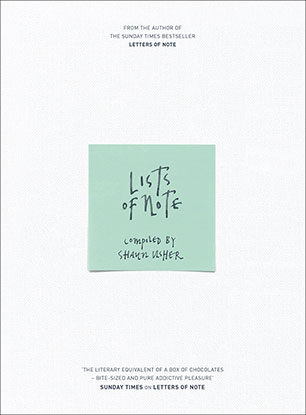 Reviewed by Magdalena Ball
Reviewed by Magdalena Ball
Lists of Note
Compiled by Sean Usher
A&U Canongate
ISBN: 9781782114529, Nov 2014, 336pages, Hardcover, $59.99usd
I think most people create lists. Shopping lists, meal plans, things that must get done, top tens, list of motivational phrases, resolutions, you name it – lists are organizational tools. Lists are also, in the main, designed to be ephemeral, thrown out the minute you tick all the items off. I have never saved a list – not even the cute ones with little boxes that my daughter makes to organize her day. Part of the joy of a list is completing it and throwing the list away – the list is only relevant while the activities or things on it are not complete. Shaun Usher has a different view of lists, and he’s made it his job to compile and keep them. You’d think that a book of lists would make dull or at least irrelevant reading, but that’s not the case.
Lists of Note contains 125 lists from some very well-known people, spanning a broad time period going as far back as Ancient Egypt, and many of these are attractive in themselves. Each list has a brief note of explanation, and often is printed in its original format, or contains an accompanying picture of the famous listmaker. Some of the lists are funny, such as Johnny Cash’s list that is not ticked off, and includes “Kiss June”, “Not kiss anyone else”, “Cough”, “Pee”, and “Worry” among other things. George Perec’s 1974 food diaries read like Gertrude Stein’s Tender Buttons. Chemist Robert Boyle’s handwritten 1662 wish list of things he hoped would one day be achieved by science is edifying and fun (since we’ve achieved quite a few of the items). Ben Franklin’s 1737 “Drinker’s Dictionary” is an alphabetical list of symptoms of drunkenness. On and on it goes. It’s not really the kind of book you’d sit and read for long periods of time, but rather something to dip into, in a spare moment, or while sitting with friends over a glass of wine. You might read a few of the lists aloud – such as Julia Child’s list of possible titles for the book she eventually called The Art of French Cuisine, or if your guests are intellectuals, Rolande Barthes list of things he likes (all romantic music, Sartre, Brecht…) and things he doesn’t like (women in slacks, strawberries, Satie). The lists are often arbitrary, as Barthes, and they’re sometimes significant, like Da Vinci’s list of things to be investigated (a working Renaissance Man’s to do list), but they’re always interesting.
The book is a large, very attractive hardbound book with full colour plates that works well on a coffee table, or as a handsome gift. Some of the portraits are particularly appealing – such as Marilyn Monroe reading on the grass, the classic B&W image of Kerouac, James Thurber reading with his glasses off, or a colour set of The Fake Books of Charles Dickens (who knew?). Ultimately, what Lists of Note shows us is that we’re not alone in our desire to tame the rush of information, tasks, and needs that bombards us everyday. Listmaking is both rational and helpful in our chaotic lives and has always been so. More importantly, Lists of Note teaches us that the list, is more than ephemera. It is a key to who we are, and at its best, can actually be a beautiful, and even artistic medium.